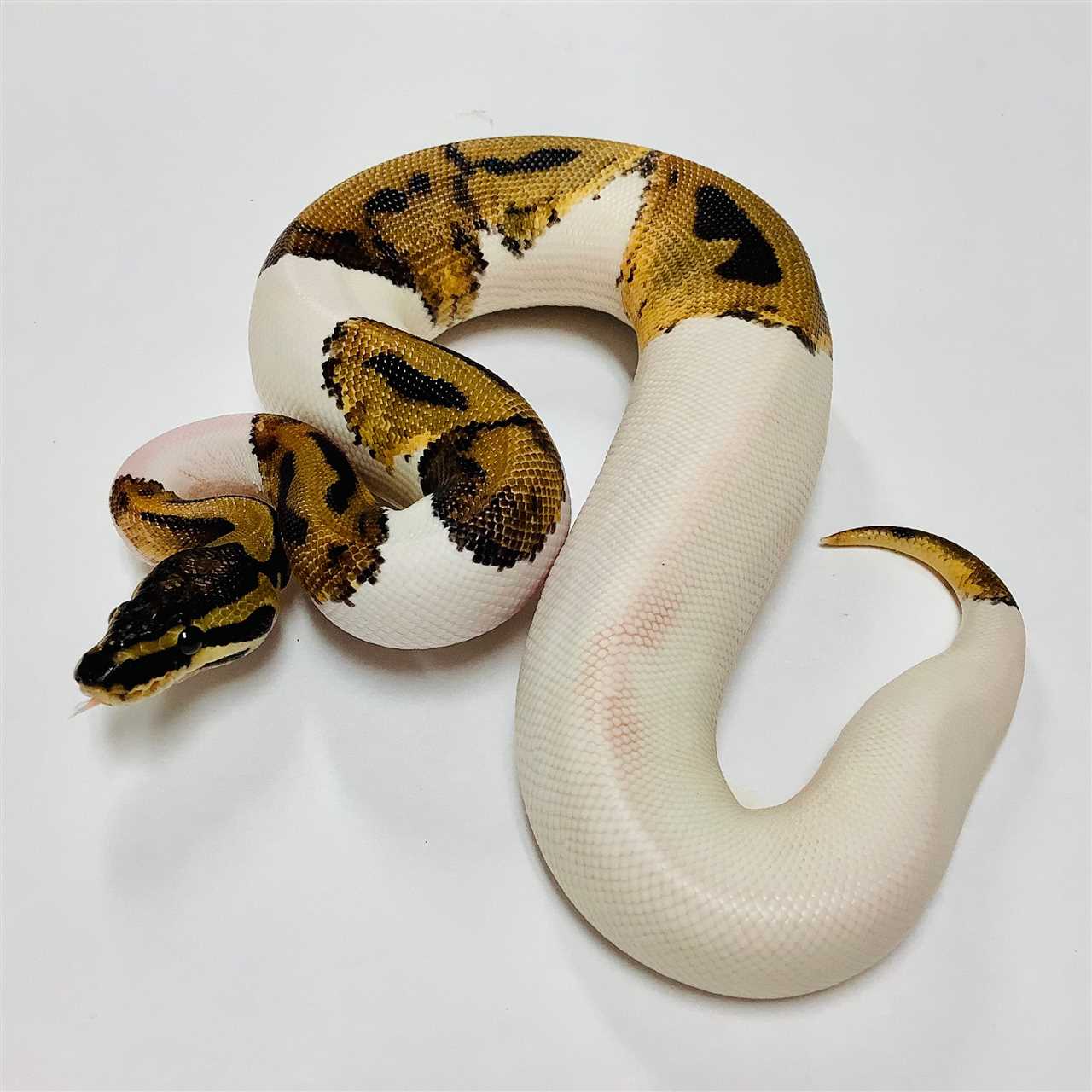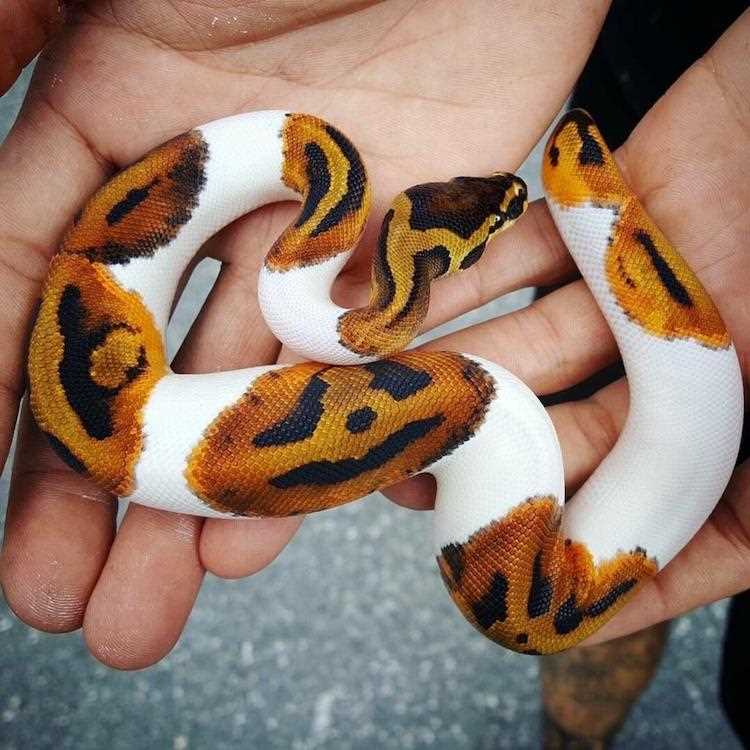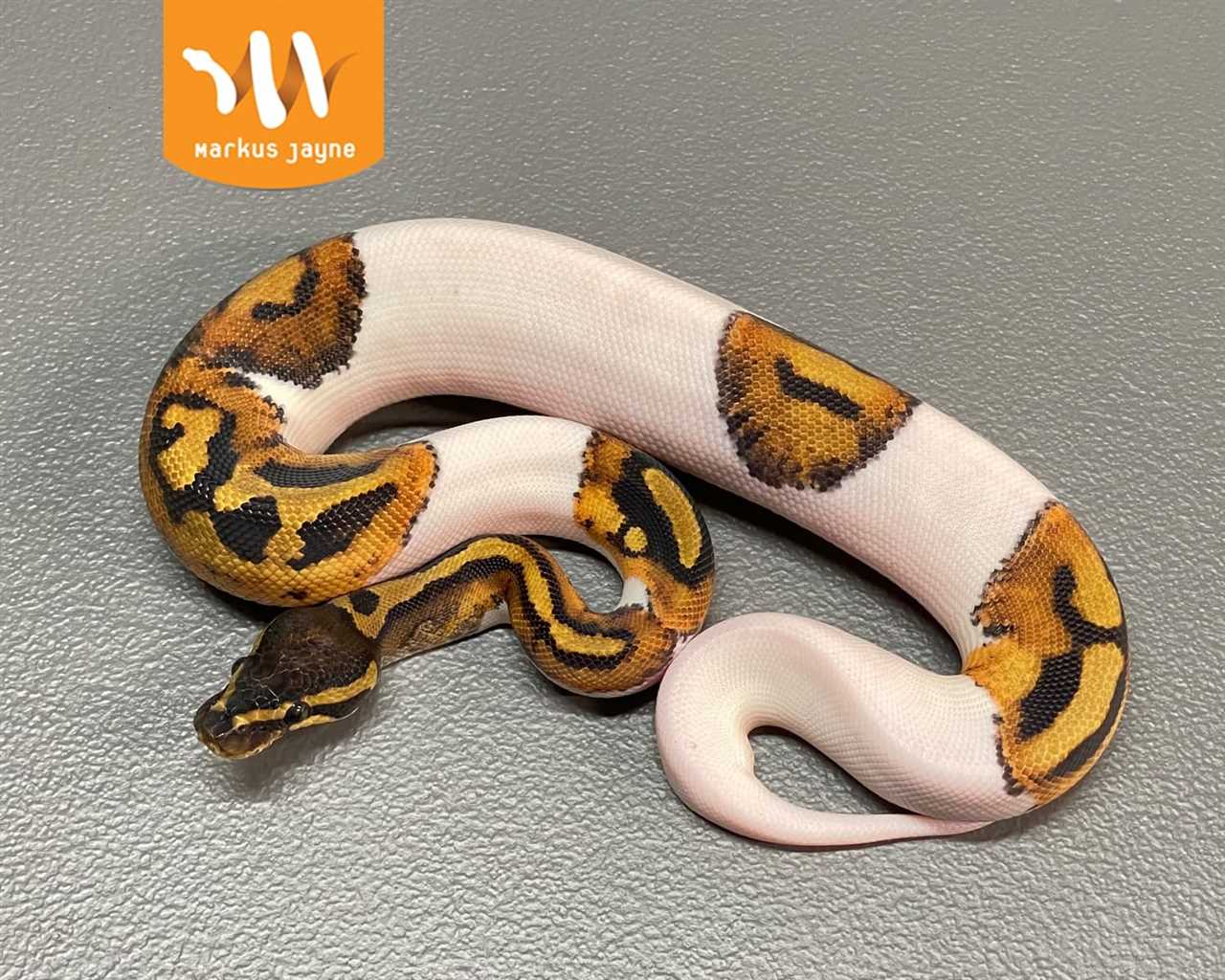The piebald mutation, which affects the pigmentation of the snake, results in a striking contrast between the typical dark scales and patches of white or light-colored scales. This random distribution of colors creates a mesmerizing mosaic-like pattern on the snake’s body.
What makes piebald pythons particularly intriguing is their unpredictability in terms of coloration. Some individuals may have large solid patches of white or light-colored scales, while others may have smaller speckled patterns. This natural variation adds to the allure of these snakes, as each piebald python is truly one of a kind.
About the Piebald Python
The Piebald Python is a unique breed of python that is known for its striking color patterns. This beautiful snake is a popular choice among reptile enthusiasts due to its distinct appearance and interesting genetic mutation.
Appearance
The Piebald Python exhibits a unique color pattern characterized by large patches of white or off-white scales interspersed with normal pigmentation. These color patches can vary in size and shape, resulting in a visually striking and highly sought-after snake.
The piebald mutation affects the distribution of pigmentation in the snake’s scales, leading to the formation of these distinctive color patterns. While the most common color combination is white and black, other variations can include shades of yellow, brown, or even orange. Each Piebald Python has a unique pattern, making them a highly individualistic breed.
The contrast between the white or off-white patches and the normal pigmentation creates a visually stunning snake that is unlike any other python breed. This unique appearance has made the Piebald Python a favorite among collectors, breeders, and reptile enthusiasts alike.
Genetics of Piebald Pythons

The Piebald Python’s distinct color pattern is the result of a genetic mutation. This mutation affects the distribution of pigmentation in the snake’s scales, leading to the formation of the characteristic white or off-white patches.
The Piebald gene is inherited in an autosomal recessive manner, meaning that both parents must carry the gene for it to be expressed in the offspring. This breeding pattern has made the Piebald Python a prized choice for breeding projects and has contributed to its status as a sought-after reptile in the pet trade.
Because of the unique genetics involved, breeding Piebald Pythons can be a complex process. Breeders must carefully select individuals with the Piebald gene and consider their breeding pairings to produce the desired color patterns in their offspring. This careful breeding process contributes to the rarity and value of Piebald Pythons in the reptile market.
About the Piebald Python
The piebald python is a popular breed among reptile enthusiasts due to its striking appearance. It has become one of the most sought-after morphs in the ball python trade, with breeders working to produce snakes with larger white patches and sharp contrasting colors.
The coloration of the piebald python can vary greatly, ranging from almost entirely white with only a few colored patches to having large patches of color with minimal white. The patterns and distribution of the color patches are unique to each individual snake, making them highly desirable among collectors.
| Characteristic | Description |
|---|---|
| Size | The piebald python can grow to be around 3 to 5 feet in length, making it a relatively small python compared to other species. |
| Diet | Like other ball pythons, the piebald python is a carnivorous reptile that feeds primarily on small mammals such as mice and rats. |
| Habitat | Piebald pythons are native to the grasslands and savannas of West Africa, where they inhabit burrows and seek refuge in underground shelters. |
| Behavior | These snakes are generally known for their docile and calm temperament. They are nocturnal hunters and spend most of their time hiding and waiting for prey. |
Overall, the piebald python is a stunning and unique reptile that continues to captivate snake enthusiasts with its breathtaking coloration and genetic variation. Its striking appearance and manageable size make it an ideal pet for reptile enthusiasts of all experience levels.
Genetics of Piebald Pythons
Piebald pythons are a fascinating reptile with a unique color pattern caused by a genetic mutation. This mutation affects the production of melanin, which is responsible for the coloration of the scales. Unlike regular pythons, piebald pythons have patches or spots of white or off-white color on their body, giving them a striking appearance.
This striking coloration is the result of a recessive gene that is inherited from both parents. When two piebald pythons breed, there is a 25% chance that each offspring will inherit the piebald gene and display the characteristic color pattern. This makes breeding piebald pythons a popular practice among reptile enthusiasts who are interested in producing these unique snakes.
The genetics of piebald pythons are still not fully understood. It is believed that the mutation responsible for the piebald color pattern affects the migration of melanoblasts, which are the cells responsible for producing melanin. This disruption in melanin production leads to the white patches or spots on the snake’s body.
Snake Scale Patterns and the Piebald Python
The piebald python is a fascinating reptile known for its unique and distinct color pattern, making it a highly sought-after breed among snake enthusiasts. This python exhibits a genetic mutation that affects the pigmentation of its scales, resulting in a beautiful and unmistakable pattern.
The Genetics of Piebald Pythons
Appearance of the Piebald Python
The color pattern of a piebald python can vary greatly from one individual to another. Some may have large, irregular patches of white on their scales, while others may display smaller, more scattered spots. The contrast between the white patches and the python’s base color, which can range from various shades of brown to black, is what gives this snake its unique and beautiful look.
The size of a piebald python can also vary, with adults typically measuring between 4 and 6 feet in length. However, some individuals may grow even larger, reaching lengths of up to 10 feet. Like other python species, the piebald python has a muscular body and a distinct triangular-shaped head.
Habitat and Distribution
The piebald python is native to parts of Africa, specifically found in the central and western regions of the continent. These pythons inhabit a wide range of habitats, including grasslands, forests, and even rocky areas. They are excellent climbers and often take refuge in trees, using their strong body muscles and flexible movement to navigate their environment.
The Piebald Python’s Color Mutation: A Phenomenon in Nature
The piebald python’s unique color pattern is a result of a natural genetic mutation. It serves as a prime example of how genetic variations can lead to fascinating and beautiful traits in various species. The distinct appearance of the piebald python has made it a popular choice for both snake enthusiasts and breeders alike.
In the next section, we will explore the behavior, feeding habits, and other interesting aspects of the piebald python’s life to further understand and appreciate this remarkable snake.
Description of the Mutation in Piebald Pythons
The piebald python is a unique reptile species known for its striking color and pattern variations resulting from a genetic mutation. This mutation affects the pigmentation of the snake’s scales, resulting in a piebald pattern that is characterized by large patches of white or off-white coloration amidst the snake’s typical coloration.
The most distinguishing feature of the piebald python is its irregular pattern of unevenly distributed patches, which can vary in size and shape. These patches can range from small specks to large areas covering the majority of the snake’s body. The color of the patches can also vary, with some piebald pythons displaying white, cream, or yellow patches.
The piebald mutation is a result of a genetic anomaly that affects the distribution and production of melanin, the pigment responsible for the snake’s coloration. This results in the incomplete development of melanocytes, which are responsible for producing melanin, leading to the formation of the unique piebald pattern.
Feeding Habits
The feeding habits of piebald pythons are similar to those of their non-piebald counterparts. They are constrictor snakes, meaning they kill their prey by coiling around them and squeezing until the prey suffocates. After killing their prey, they dislocate their jaws and swallow it whole.
Feeding time can be a fascinating experience to observe. The snake will strike at the prey item, grab it with its teeth, and then proceed to coil around it. The python’s jaws are equipped with sharp teeth that point backwards, allowing them to prevent the prey from escaping.
| Pros of Feeding Live Prey | Cons of Feeding Live Prey |
|---|---|
| – Stimulates natural hunting behavior | – Risk of injury to the snake |
| – Provides mental stimulation | – Risk of escape or hiding by the prey |
| – Can be easier to get the snake to feed | – Possibility of introducing parasites or diseases |
Reproduction and Lifespan
The reproduction and lifespan of piebald pythons are fascinating aspects of these unique reptiles. As with other python species, piebald pythons reproduce by laying eggs. Female pythons typically lay a clutch of eggs once a year, with the size of the clutch ranging from 8 to 30 eggs, depending on the size and health of the individual. The eggs are usually laid in a warm, secluded area where they are protected from predators.
After the eggs are laid, the female python coils around them to provide warmth and protection. The incubation period lasts for approximately 60 to 90 days, during which the eggs are kept at a temperature of around 88 to 90 degrees Fahrenheit (31 to 32 degrees Celsius). Once the eggs hatch, the baby piebald pythons emerge from their shells and are ready to start their independent lives.
As with any reptile, it is essential to provide a well-maintained and appropriate habitat for the python’s lifespan. This includes a spacious enclosure with suitable hiding spots, proper lighting and heating, and a balanced diet. Regular veterinary check-ups and proper handling are also crucial for ensuring the health and longevity of your piebald python.
The Conservation Status of the Piebald Python
The piebald python, known for its unique color mutation, is a fascinating breed of snake that has captivated the attention of reptile enthusiasts. However, the conservation status of this magnificent creature is a topic of concern.
Due to their distinct color pattern, piebald pythons are highly sought after by collectors and breeders, which has led to a decline in their population in the wild. This demand has put pressure on the species, making it vulnerable to overexploitation.
While it is true that piebald pythons can be bred in captivity, it is crucial to ensure that these breeding programs are done responsibly and ethically. The demand for these unique snakes must be met by sustainable breeding practices that prioritize the well-being and conservation of the species.
Conservation efforts should focus on protecting the natural habitats of piebald pythons, as well as regulating the trade and sale of these snakes. By implementing strict regulations and monitoring the population, it is possible to prevent the exploitation of this species and preserve it for future generations.
Additionally, educating the public about the importance of conservation is essential in raising awareness and promoting responsible ownership of piebald pythons. This education should emphasize the need to respect the natural habitat and behavior of these reptiles, as well as discourage the illegal trade of wild-caught specimens.
It is crucial to recognize the role that piebald pythons play in the ecosystem. As predators, they help maintain ecological balance by controlling populations of small mammals and other reptiles. By preserving their natural habitats and ensuring their continued existence, we can contribute to the overall health and diversity of our environment.
Keeping Piebald Pythons as Pets
Keeping a piebald python as a pet can be a rewarding experience for reptile enthusiasts. These unique snakes are sought after for their distinctive coloration and fascinating genetics. However, they also require specific care and attention to ensure their health and well-being.
Piebald Python Breed
Piebald pythons are a specific breed of snake that exhibit a genetic color mutation. This mutation causes patches of pigment to be absent in their scales, resulting in a striking piebald pattern. These snakes are highly desired among reptile breeders and collectors.
Care Requirements
It is crucial to maintain the appropriate humidity level in the enclosure, as piebald pythons require high humidity to shed properly. This can be achieved by providing a water bowl and misting the enclosure regularly. Additionally, a proper substrate should be used to mimic their natural habitat and allow for burrowing.
Feeding and Handling
Piebald pythons are carnivorous reptiles and should be fed a diet consisting of appropriately sized rodents, such as mice or rats. The size of the prey should be proportional to the size of the snake. It is recommended to feed them once every 1-2 weeks, depending on their size and age.
Health Considerations

Regular veterinary check-ups are also recommended to ensure the snake’s health and to address any potential issues before they become serious. Maintaining a clean and properly maintained enclosure is essential to prevent the spread of parasites and bacteria that can affect the snake’s health.
Legal Considerations

Handling and Care
Piebald pythons are a unique and mesmerizing breed of python known for their striking piebald pattern, which is a result of a genetic mutation. This mutation affects the coloration of their scales, resulting in a combination of white or light-colored patches on a dark background. The contrast between the two colors creates a visually stunning appearance that sets them apart from other python species.
When handling a piebald python, it’s essential to approach it calmly and confidently. Make sure to support its body properly, holding it with both hands and avoiding any sudden movements that could startle or agitate the snake. It’s also recommended to handle your piebald python in a calm, quiet environment to minimize stress.
In terms of care, piebald pythons have similar needs to other python species. They require a consistent heat source to maintain their body temperature, as well as a clean and well-maintained enclosure. Regular feeding with appropriate-sized prey items is also important to ensure their nutritional needs are met.
Common Health Issues of Piebald Pythons
One of the most common health issues seen in piebald pythons is the occurrence of scale and skin problems. Due to the piebald mutation, these pythons have irregular pigmentation patterns, which can sometimes result in thinner and more fragile scales. This can lead to skin infections, shedding difficulties, and even injuries. As a responsible owner, it is essential to regularly inspect your python’s skin and scales for any abnormalities, and consult a veterinarian if necessary.
Another important aspect of keeping piebald pythons healthy is maintaining their proper diet and nutrition. These snakes are typically fed a diet of mice or rats, depending on their size and age. However, it is crucial to ensure that the prey items are of the right size and nutritional composition. Inadequate nutrition can lead to various health problems, such as vitamin deficiencies, metabolic bone disease, and obesity. Providing a balanced and appropriate diet is vital for the overall well-being and longevity of your piebald python.
Lastly, another health concern for piebald pythons is the risk of parasites. These snakes can be susceptible to internal and external parasites, such as mites, ticks, and internal worms. Regularly inspecting your python for any signs of parasites, such as visible bugs or behavioral changes, is essential. If parasites are detected, prompt treatment should be administered under the guidance of a veterinarian to prevent any further complications.
Legal Considerations
In the United States, for example, the possession of certain python species may require a permit or may be banned altogether. This is due to concerns about the potential environmental impact and risks posed by escaped or released pythons. It is crucial to understand and follow the legal requirements to ensure the well-being of the snakes and avoid any legal consequences.
Before acquiring a piebald python, it is recommended to check with local authorities, such as state wildlife agencies or reptile-specific organizations, to determine the legality of ownership. They will be able to provide information on any permits or licenses required and any restrictions on housing, transportation, and breeding.
In addition to legal considerations, it is essential to consider the responsibilities and challenges associated with owning a piebald python. These snakes can live for several decades and require a specific habitat, temperature, and feeding routine. Keeping a piebald python as a pet is a commitment that should not be taken lightly.

I’m Lena Adams—a product of an unconventional upbringing in the African wilderness. My father, a daring explorer of African wildlife, sparked my fascination with reptiles, a passion that intertwined with the tragic loss of my mother during an expedition, leaving an indelible mark on my life. Driven to understand the creatures that captivated my parents, I embarked on my journey, sharing insights about reptiles, frogs, and lizards on my website. Through my explorations and conservation efforts, I honour my family’s legacy while seeking connections—to the creatures, nature, and the mother whose presence I yearn to understand.
